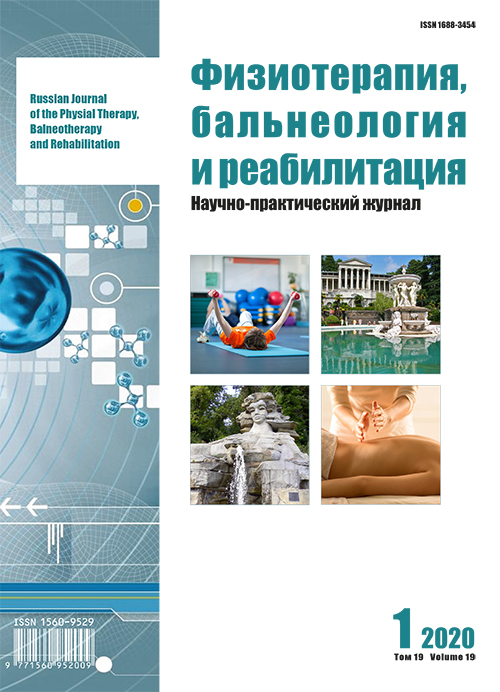Assesment of osteoporotic fractures risk and osteoporosis prevalence among patients over 50 years old undergoing medical rehabilitation
- Authors: Marchenkova L.A.1, Makarova E.V.1, Gerasimenko M.Y.2, Evstigneeva I.S.2
-
Affiliations:
- National Medical Research Center for Rehabilitation and Balneology
- Russian Medical Academy of Continuous Professional Education
- Issue: Vol 19, No 1 (2020)
- Pages: 13-19
- Section: Original studies
- Published: 15.03.2020
- URL: https://rjpbr.com/1681-3456/article/view/41815
- DOI: https://doi.org/10.17816/1681-3456-2020-19-1-2
- ID: 41815
Cite item
Abstract
Background. Back pain, limitation of mobility, spinal deformity, decreased ability to self-care due to osteoporotic fractures (vertebrae, femoral neck, humerus, etc.) are one of the reasons for referring patients to rehabilitation and rehabilitation treatment, which involves the use of physical therapy methods, physiotherapy exercises and mechanotherapy.
Objective: to assess the prevalence of osteoporosis (OP), individual risk factors for OP, as well as the proportion of people with high risk of osteoporotic low-energy fractures among patients over 50 years old undergoing treatment according to the “medical rehabilitation” profile.
Methods. The study group comprised of 600 patients (426 women and 174 men) aged 50 to 84 years, average age 64.25±10.17 years, undergoing treatment in a rehabilitation department. This was a cross-sectional study in the form of unified questionnaire, including data conserning age, weight, height, BMI, clinical and rehabilitation diagnosis, anamnesis of the main disease, anamnesis vitae, presence of OP diagnosis in the anamnesis, its treatment, OP risk factors estimation. An assessment of 10-year probability of osteoporotic fractures was carried out using Russian model of online FRAX® calculator.
Results. 41.8% patients in the study sample had OP risk factors, including 31.2% ― 3 risk factors or more. 38% patients over 50 years old undergoing medical rehabilitation showed a high fracture risk according to the FRAX calculator. 34.1% had a diagnosis of OP stated, and 45.8% already had osteoporotic fractures. Among those who did not undergo densitometry examination, 69.9% had a history of low-traumatic fractures, and only 58.5% of patients with an established diagnosis of OP and 26.8% of those at high risk of fractures received effective therapy for OP.
Conclusion. Among patients over 50 years old undergoing medical rehabilitation a high frequency of OP and high fracture risk were stated. At the same time, insufficient quality of OP diagnostics and anti-osteoporotic therapy administaration were revealed.
Full Text
About the authors
Larisa A. Marchenkova
National Medical Research Center for Rehabilitation and Balneology
Author for correspondence.
Email: marchenkovala@nmicrk.ru
ORCID iD: 0000-0003-1886-124X
SPIN-code: 9619-8004
MD, PhD
Russian Federation, MoscowEkaterina V. Makarova
National Medical Research Center for Rehabilitation and Balneology
Email: rue-royal@inbox.ru
ORCID iD: 0000-0003-3767-8475
SPIN-code: 1305-6152
MD
Russian Federation, MoscowMarina Yu. Gerasimenko
Russian Medical Academy of Continuous Professional Education
Email: mgerasimenko@list.ru
ORCID iD: 0000-0002-1741-7246
SPIN-code: 7625-6452
MD, PhD, Professor
Russian Federation, MoscowInna S. Evstigneeva
Russian Medical Academy of Continuous Professional Education
Email: evstigneevais@mail.ru
ORCID iD: 0000-0001-9128-0965
MD, PhD
Russian Federation, MoscowReferences
- Borgström F, Karlsson L, Ortsäter G, et al.; International Osteoporosis Foundation. Fragility fractures in Europe: burden, management and opportunities. Arch Osteoporos. 2020;15(1):59. doi: 10.1007/s11657-020-0706-y.
- Choksi P, Jepsen KJ, Clines GA. The challenges of diagnosing osteoporosis and the limitations of currently available tools. Clin Diabetes Endocrinol. 2018;4:12. doi: 10.1186/s40842-018-0062-7.
- Lesnyak OM, Baranova IA, Belova KYu, et al. Osteoporosis in Russian Federation: epidemiology, medico-social and economic aspects of the problem (a review). Travmatologiya i ortopediya Rossii. 2018;(1):155–168. (In Russ).
- O’Brien M. Exercise and osteoporosis. Irish J Med Sci. 2001;170:58–62. doi: 10.1007/BF03167724.
- Sinaki M. Stronger back muscles reduce the incidence of vertebral fractures: a prospective 10 year follow-up of postmenopausal women. Bone. 2002;30(6):836–841.
- Sinaki M. Exercise for patients with osteoporosis: management of vertebral compression fractures and trunk strengthening for fall prevention. PM R. 2012;4(11):882–888. doi: 10.1016/j.pmrj.2012.10.008.
- Sinaki M, Mikkelsen BA. Postmenopausal spinal osteoporosis: flexion versus extension exercises. Arch Phys Med Reh. 1984;65(10):593–596.
- Dusdal K, Grundmanis J, Luttin K, et al. Effects of therapeutic exercise for persons with osteoporotic vertebral fractures: a systematic review. Osteoporos Int. 2011;2:755–769. doi: 10.1007/s00198-010-1497-6.
- Giangregorio LM, Macintyre NJ, Thabane L, et al. Exercise for improving outcomes after osteoporotic vertebral fracture. Cochrane Database Syst Rev. 2013;(1):CD008618. doi: 10.1002/14651858.CD008618.pub2.
- Howe TE, Shea B, Dawson LJ, et al. Exercise for preventing and treating osteoporosis in postmenopausal women. Cochrane Database Syst Rev. 2011;(Issue 7):CD000333. doi: 10.1002/14651858.CD000333.pub2.
- Lesnyak OM. A new paradigm in diagnostics and treatment of osteoporosis: forecasting a 10-year absolute risk of fracture (FRAXTM calculator). Osteoporosis and Osteopathy. 2012;(1):23–28. (In Russ).
- Clinical recommendations for the prevention and management of patients with osteoporosis. Ed by O.M. Lesnyak. Yaroslavl: Litera; 2012. Р. 11–12. (In Russ).
- Mazurov VI, Lesnyak OM, Belova KYu, et al. Algorithms for the choice of therapy for osteoporosis in the provision of primary health care and the organization of preferential drug provision for certain categories of citizens entitled to receive state social assistance. Systematic review and resolution of the Expert Council of the Russian Association for Osteoporosis. Preventative medicine. 2019;22(1):57–65. doi: 10.17116/profmed20192201157. (In Russ).
- Marchenkova LA. Postmenopausal osteoporosis as a medical, social and economic problem of the 21st century. Farmateka. 2015;(54):13–21. (In Russ).
- Marchenkova LA, Dreval AV, Dobritsyna M.A. Adherence to the prevention of osteoporosis and factors affecting it in residents of the Moscow region. Osteoporosis and osteopathy. 2014;17(1):12–17. (In Russ).
Supplementary files







